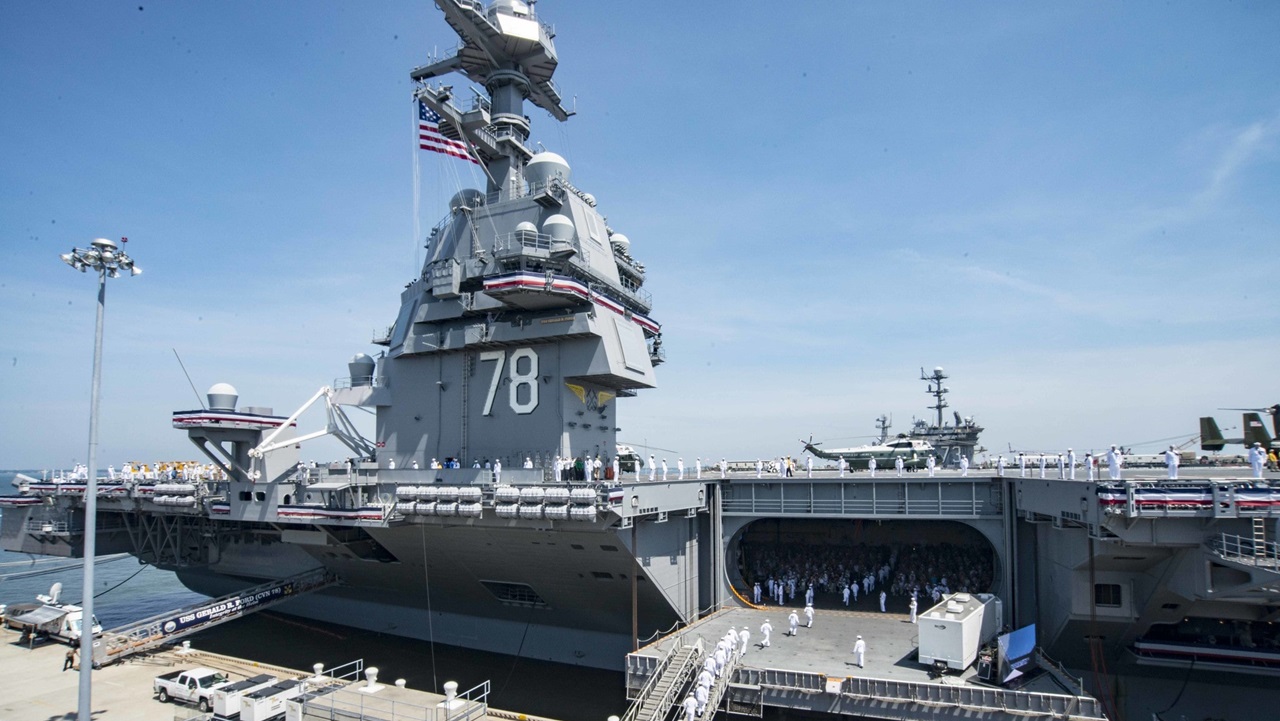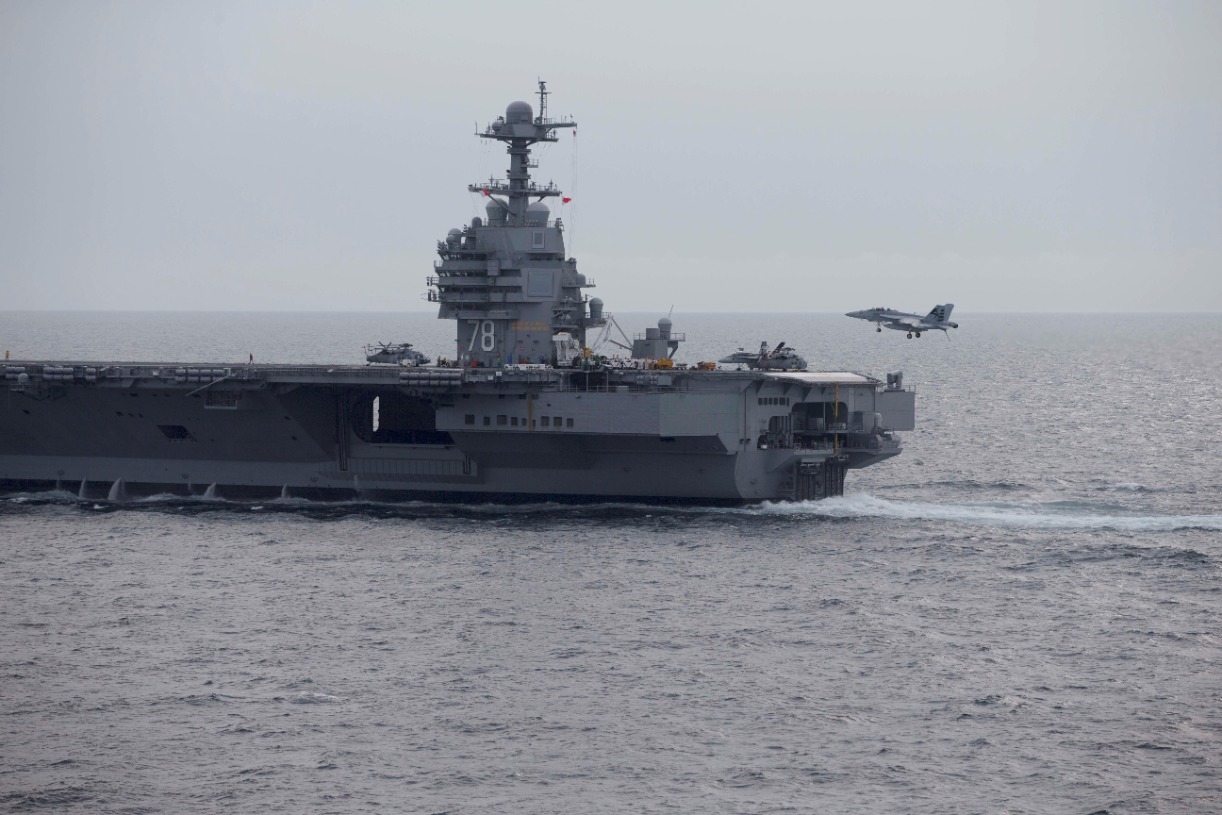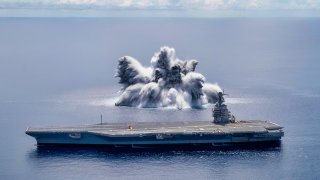The Navy's Ford-Class Aircraft Carriers are a Giant 'Question Mark'
The U.S. Navy’s new Gerald R. Ford-class aircraft carriers are set to replace the aging Nimitz-class carriers with several advanced features such as EMALS, improved nuclear reactors, advanced arresting gear, and advanced weapons elevators.
Summary: The U.S. Navy’s new Gerald R. Ford-class aircraft carriers are set to replace the aging Nimitz-class carriers with several advanced features such as EMALS, improved nuclear reactors, advanced arresting gear, and advanced weapons elevators.

-However, their high cost, construction delays, maintenance challenges, and vulnerability to modern threats like hypersonic missiles and cyber-attacks raise questions about their viability.
-Considering alternative strategies, such as enhancing conventional carriers or using more amphibious assault ships, might be more effective and efficient for future naval warfare needs.
Amid evolving threats like hypersonic missiles and cyber attacks, questions arise about the viability of these massive vessels. The article explores whether the Navy should consider alternative strategies, such as updating conventional carriers or increasing the use of amphibious assault ships, suggesting a reevaluation of supercarrier utility in contemporary naval warfare.
Ford-Class vs. Nimitz-Class Aircraft Carrier
Over the coming decades, the U.S. Navy will replace its aging Nimitz -class carriers with the slightly larger and more advanced Gerald R. Ford- class carriers. The latter nuclear-powered flattops were designed using decades of experience in carrier operations with the Nimitz class, while also incorporating numerous advancements.
Innovations in the Ford class include automation, allowing for a crew of several hundred fewer sailors; an Electromagnetic Aircraft Launch System in place of traditional steam catapults; a new nuclear reactor design for greater power generation; and the ability to carry more aircraft and operate with a variety of unmanned combat aerial systems.
On paper, the Gerald R. Ford class is an impressive warship that can project power for decades to come. Future warships in the class will probably feature additional improvements, and will almost certainly be the most advanced carriers ever built.
Yet as the largest warship ever constructed in terms of displacement, the USS Gerald R. Ford (CVN-78) arrived several years late – and at $13.3 billion, it is also the most expensive warship ever built. There are issues with numerous systems that did not exactly work out as planned. From the ship's toilets, which regularly clog, to the ordnance elevators that didn't function properly during sea trials, the ship had teething issues that needed to be resolved.
The Problems Continue
Though CVN-78 has completed an extended deployment to the Mediterranean – where the carrier was on station to help ensure the Israel-Hamas War wouldn't escalate – the vessel is now preparing for additional upgrades that were delayed during construction. This was not unexpected, but it highlights a problem facing the U.S. Navy's aircraft carrier industrial base.
The shipyards and suppliers that make up the base are struggling to meet anything resembling a schedule. CVN-78 was years late, and we can expect more of the same with each ship to come. As a result, the U.S. Navy has been forced to extend the service lives of its oldest nuclear-powered supercarriers, like a struggling family that is forced to keep its old minivan for another year.
But carriers are not minivans. They are critical components of U.S. national defense and power projection.
Was There a Case for Keeping the Nimitz?
Should a case have been made to stick with the "devil you know," by simply improving the Nimitz class? The answer here would be a resounding, "No!"
For one thing, the Ford class was already based largely on the Nimitz-class design and was an evolutionary step forward.
The question to ask is whether supercarriers should even be built.
Given the protection that is provided by a carrier strike group, it would be very difficult for an adversary to score a direct hit on a carrier. Difficult, but not impossible – supercarriers are really big targets. The old fear was from enemy aircraft and submarines, but the threat to carriers now includes hypersonic missiles, undersea unmanned vehicles, and unmanned aerial vehicles. Low-tech threats remain a concern, as was seen on October 12, 2000, when suicide terrorists exploded a small boat alongside the USS Cole.
It wouldn't take all that much to do considerable damage to such a high-value target. An enemy only has to get lucky once.
In addition, the systems are now so complex that they could even be targeted in a cyber attack.
The question is whether the U.S. Navy needs such a massive floating airbase that faces so many threats.
Replacement Cycle
The biggest argument against a nuclear-powered carrier is that it really is not an efficient system. Yes, such a vessel has nearly unlimited range, but in reality its endurance is only as great as the food and water it can carry. A ship that can stay at sea indefinitely is good until one considers that it still needs to be supplied with fuel for the aircraft and food for the crew.
During the Covid-19 pandemic, the USS Nimitz (CVN-68) completed the longest deployment of a carrier since the Vietnam War, spending 321 days at sea. It was hardly good for the crew, who had to endure 10 months at sea, but it also pushed the ship hard. The carrier required a lengthy maintenance period when it finally returned to port. Even worse, the Nimitz-class USS Theodore Roosevelt (CVN-71) was sidelined for months due to an outbreak of Covid. Massive vessels with massive crews are especially vulnerable to such outbreaks.
Even the regular maintenance of these supercarriers can take months, and the mid-life refueling of their nuclear reactors takes the ships out of service for years. The Navy may have 11 nuclear-powered carriers in its fleet, but rarely are more than five or six deployed at any one time.
Life Cycle Woes
Finally, there seems to be little planning for these supercarriers’ end-of-life. Even as the cost to construct the next ships in the class has fallen, the Navy will have to pay to eventually dispose of these vessels. It was reported that it could take more than a decade and a half to fully dismantle and scrap the USS Enterprise (CVN-65), the first nuclear-powered aircraft carrier, and the price tag could be more than $1.5 billion.
Even once the issues with CVN-65 are addressed, the Navy will have to deal with the Nimitz-class carriers that the new Ford class will replace on a one-for-one basis. This issue isn't likely to get better with the newest carriers being built.

Each may be impressive, but Ford-class carriers take years to build, cost a fortune, require extensive maintenance, and will take years to dismantle.
Perhaps it would be wiser to update the conventionally powered Kitty Hawk class, and complement them with more America-class amphibious assault ships, which would be better suited to a potential war in the Indo-Pacific. Each of those flattops would be cheaper to build, and easier to retire when the time comes. Finally, they aren't a nuclear disaster waiting to happen should a terrorist get lucky.

Author Experience and Expertise: Peter Suciu
Peter Suciu is a Michigan-based writer. He has contributed to more than four dozen magazines, newspapers, and websites with over 3,200 published pieces over a twenty-year career in journalism. He regularly writes about military hardware, firearms history, cybersecurity, politics, and international affairs. Peter is also a Contributing Writer for Forbes and Clearance Jobs. You can follow him on Twitter: @PeterSuciu.
You can email the author: [email protected].
All images are Creative Commons.


